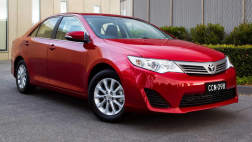It has slashed 350 jobs from the workforce at its factory at Altona in Melbourne as a result of falling demand for the Camry, most notably in the Middle East, that pegs production for 2012 at just 95,000 cars.
That's a drop of more than 30 per cent in just four years, to an unsustainable level without cuts to the 3500-strong Victoria workforce.
"Toyota Australia is facing severe operating conditions resulting in unsustainable financial returns due to factors including the strong Australian currency, reduced cost competitiveness and volume decline, especially in export markets," says Max Yasuda, president of Toyota Australia.
But Toyota is not alone on the crisis line. Falcon sales fell to less than 19,000 cars in 2011 and the total production at Broadmeadows - including Falcon ute and Territory - was only 45,000 vehicles, while the Commodore lost the top spot in Australian motoring last year and GM Holden is now relying on joint production of the Commodore and compact Cruze to keep its Adelaide factory spinning at profitable levels.
Less than two weeks ago the spotlight was on Detroit with questions about the future of both Ford and Holden. The blue oval brand reacted first with a $103 cash injection and General Motors is promising news by the middle of the year on a production deal beyond the next Commodore, the VF that hits the road in 2014.
Planning the future for Australian manufacturing is being done at the highest levels, with the Federal Minister for Industry, Senator Kim Carr, meeting Ford CEO Alan Mulally and GM honcho Dan Akerson
The major focus was development of a fresh co-investment strategy between the Federal government and the carmakers, taking advantage of the $3.4 billion fighting fund included in the Automotive Transformation Scheme as part of the motor industry plan that runs through to the end of the decade.
Senator Carr was upbeat when he emerged from the talks, firstly to pledge his support of Holden and then to announce the new Ford deal which has been fast-tracked in less than six months. "We had very, very productive conversations. We are at the table," he says.
But that was ahead of the Toyota job cut, which is also raising questions about the future viability of the hundreds of component companies that are tied to Ford, Holden and Toyota.
“This is an industry that employs 46,000 skilled Australian workers directly and over 200,000 indirectly. It is an industry that is the cornerstone of research and development activity in Australia and an industry that is one of our top export earners," says Carr.
“The enormously competitive situation for automotive globally highlights more than ever the need to support our local automotive industry, to retain core capabilities and to provide skilled jobs so that the industry can rebound when economic conditions improve.
“The mining boom won’t last for ever and we need to make sure that we have a core of key manufacturing industries with export potential – including automotive – to turn to when that happens."
Break-Out: Funding
- The troubles at Toyota have again raised questions about government support for carmaking in Australia.
- The three locals all get some form of support from Federal and State governments, with Ford Australia recently announcing a $103 million co-funded injection from Canberra and its parent company in Detroit.
- There has been talk in recent years that taxpayers are funding the industry at the rate of more than $1000 a person every year, but a new independent survey by the Sapere group shows the reality.
- The actual cost of government backing is $17.30 a year - a level that Sapere rates as the lowest among countries in the Organisation for Economic Co-operation and Development.
- The level of support in Britain is only $27.270 but it rises sharply from there, to $87.90 in Germany and $93.70 in Canada to $143.30.
- At the top end, government support in France is $143.30 per person and in the USA it's a whopping $257.40.
Break-Out: Opinion
- The troubles at Toyota reflect the latest change for Australian carmakers.
- The best model for success in the 1990s and early 2000s was to have a strong local sales base and then cream the top with an export program.
- It worked for Holden with the Pontiac G8 version of the Commodore, and Ford also looked for a time at building the Focus in Australia for exports through the Asia-Pacific region.
- Toyota did it best with the Camry and in its peak export year, it shipped more than 100,000 Camrys from Altona to the Middle East.
- But carmaking has contracted, the Australian dollar is far stronger, and the best model now is to export expertise - not cars - with work like Ford's T6 pickup program, Holden's design job for the Chevrolet Camaro, and even Toyota's inhouse design jobs.
- There is still a place for the local makers, but they have to be tightly integrated into a global plan that means more for Australia than just trying to crank out orphan cars for local buyers.





.jpg)

.jpg)
.jpg)

.jpg)


.jpg)




.jpg)
.jpg)
.jpg)
.jpg)



 (1).jpg)



